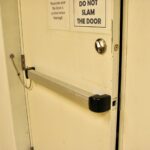The other day, someone asked me how a fire door with fire exit hardware can pass the hose-stream portion of the fire test. Their concern was that the force of the water from the fire hose would depress the touchpad of the fire exit hardware, and the door would unlatch.
A related question that comes up on occasion is whether it’s acceptable to use less-bottom-rod fire exit hardware with an auxiliary fire pin on an egress door. The pin projects when heated to a high temperature, and aligns and secures the doors to help deter the spread of smoke and flames.
Before I answer, take a look at this photo of a door with fire exit hardware after completion of the fire test (this was the intended and expected outcome):
During a fire test, and potentially during a fire, the operable hardware on the door melts away and/or is deactivated by fusible material inside of the product. The latching portion remains, as the door is required to be latched for the entire duration of the test – including the hose-stream portion. But the parts normally used to retract the latch – the lever, touchpad, crossbar, etc. – no longer function in that capacity.
NFPA 101 includes a specific reference to this situation:
7.2.1.5.1 Door leaves shall be arranged to be opened readily from the egress side whenever the building is occupied.
7.2.1.5.2* The requirement of 7.2.1.5.1 shall not apply to door leaves of listed fire door assemblies after exposure to elevated temperature in accordance with the listing, based on laboratory fire test procedures.
A.7.2.1.5.2 Some fire door assemblies are listed for use with fire pins or fusible links that render the door leaf release inoperative upon exposure to elevated temperature during a fire. The door leaf release mechanism is made inoperative where conditions in the vicinity of the door opening become untenable for human occupancy, and such door opening no longer provides a viable egress path.
The International Building Code (IBC) also addresses this:
1010.1.9.3 Locks and latches. Locks and latches shall be permitted to prevent operation of doors where any of the following exist:
5. Fire doors after the minimum elevated temperature has disabled the unlatching mechanism in accordance with listed fire door test procedures.
So to answer the original questions, the hose stream does not actuate the touchpad of the fire exit hardware because the touchpad is no longer able to retract the latch. And the LBR pin is acceptable because the doors and hardware are not operable for egress when the doors reach the temperature at which the pin is projected.
Any questions?
You need to login or register to bookmark/favorite this content.







I’ve talked with our local door contractor about fusible links & fire pins within doors, and he mentioned that (specifically for less bottom rod doors) the fire pins can cause issues for Fire Fighters if they are required to pass through a pair of double doors which have been pinned together.
Do you know of any products or solutions which allow firefighters access through pinned doors?
What are your thoughts about the risk of fire pinned doors to firefighters, is it a situation which commonly occurs?
Great picture Lori. This could be useful when clients ask me the difference between fire exit device vs. normal panic device.
Very interesting article. These are things that I’ve never considered. Thank you!
So in this instance, the hose stream originated from what would be the INSIDE of the building? (the touch pad side)
Having only seen videos of fire tests with cylindrical or mortise locks, I’m not sure how that works. I’m assuming the test door is mounted to open IN so that the exit device latch can be proven to withstand the hose stream?
Hi Terry –
Here’s a blog post about that: https://idighardware.com/2016/08/fire-exit-hardware-under-fire/.
– Lori
I never really thought about the hardware making the door inoperable in a fire. How do the fire fighters get past the door then to extinguish the fire?
Its called forcible entry. Something we practice with relish. That’s why we bring a “set of irons” with us (haligan tool and an ax).
Hi Lori,
the latchbolt in rim type or vertical rods has a pin that will be projected at 175 degree which make the latchbolt unoperable.
Even LBR has the same function
The use of fire pins is documented in DHI article in 2007
https://www.dhi.org/shared/forms/PDFforms/Publications/DH_07/2_Feb07/Feb07_5_Thermal%20Pins.pdf
Some would argue that if a fireman needs to go thru that door after the fire, he or she will get there with his or her axe.
Hi Paul –
There’s also an article here: https://idighardware.com/2012/07/decoded-less-bottom-rod-fire-exit-hardware/, and I have the documentation from UL and others from the article if it’s ever needed. I have not had any AHJs worrying about it lately, now that people understand how it works.
– Lori
I appreciate learning new things. Understanding how fire-rated doors are installed and designed to function, and passing it on to other firefighters helps us do our job.
Wow, super interesting in that in over 30 years in the fire service, and about 20 as a Life Safety Code inspector, I never have heard about the hardware being designed to fail in the locked position. As noted, we’re prepared for forcing entry, but that is not something we would anticipate when exiting. What is the elevated temperature that is the allowable “fail point”?
Hi Adam –
I don’t know what the temperature is for all types of hardware, but I do have information on the auxiliary fire pin that is used with LBR (less-bottom-rod) fire exit hardware. The pin, mounted at approximately 12 inches above the floor, projects when the temperature reaches about 400-450 degrees F. According to UL, this usually happens 15-20 minutes into the fire test, when the temperature inside the test furnace is approximately 1,400 degrees.
– Lori
Thanks Lori, all of this is helpful to us as info to tuck away and teach “just in case”.